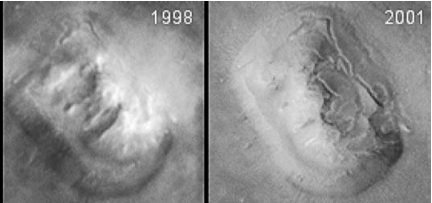The Face You See on Mars Surface - Pareidolia and Self-Deception
On the 25th of July, 1976, Viking 1 Orbiter took several pictures of the Cydonia Martian region during a mission to the red planet. One of the images received particular attention from the public:

At a first glance it is easy to note a striking resemblance with a human face. Conspiracy theorists, adepts of magical thinking, and many from the non-scientific-educated public hypothesized that what they saw was the work of aliens.
Mars Global Surveyor took pictures of the same region about 20 years later:

Looks like our friends, the aliens, were trying to cover up their traces.
As it was pointed out from the very beginning, the images were nothing more than the result of natural forces like erosion and winds and the light and shadow effects at the time the 1976 image was taken. We should give proper credit to The Sun for that...
But conspiracy theorists don't buy it. According to Rob Carroll:
"This soon gave birth to the claim that the face was a sculpture of a human being located next to a city whose temples and fortifications could also be seen. Some began to wonder:
Were these built by the same beings who built the ancient airports in Nazca, Peru, and who were now communicating to us through elaborate symbols carved in crop circles?"
This is probably the classic example of pareidolia. In psychology, pareidolia refers to seeing/detecting patterns where there are none. Other examples are:
- images of human faces, objects, animals, and even religious figures in cloud formations
- the moon rabbit
- the man in the moon
- the face of Jesus in the stump of a tree
- hidden messages in records/music played backwards
Do an image search on these and amaze/amuse yourself!
Carl Sagan, an astronomer, thinks pareidolia is an ingrained trait we acquired through evolution. In his 1995 book The Demon Haunted World he explains:
"As soon as the infant can see, it recognizes faces, and we now know that this skill is hardwired in our brains. Those infants who a million years ago were unable to recognize a face smiled back less, were less likely to win the hearts of their parents, and less likely to prosper. These days, nearly every infant is quick to identify a human face, and to respond with a goony grin."
While this may be beneficial for us in recognizing faces, there may be other explanations for pareidolia towards animals and objects.
According to Dr. Stephen Novella, clinical neurobiologist and Senior Editor of Science Based Medicine:
"Humans have a well-documented tendency for pattern recognition. It is both a great cognitive strength but also can be a weakness because we may see patterns that do not actually exist. We constantly recognize illusory patterns, which are manifested in pareidolia, data mining, hyperactive agency detection, and superstitious thinking."
What to do?
It may be clear that thanks to evolution we are error-prone when it comes to detecting patterns in randomness. It can often do us more harm than good.
We come to life prepackaged with numerous heuristics and biases. They may have served us well in a dangerous primordial world where we could have fallen prey to predatory animals. But this is rarely the case today.
We should respond to our flawed brain by raising our thinking above its faulty factory defaults. We can do this through:
- critical thinking
- metacognition - thinking about thinking (analyzing how our thought processes undergo)
- healthy skepticism and systematic doubt for the claims of others
- systematic doubt towards our own thoughts (to avoid self-jeopardy)
In research we also do this by appropriately applying the scientific method; it can also be applied to everyday life.
Thinking is what we do not posses by nature. Thinking, like any other skill, is developed through deliberate practice. I'll keep saying this until it spills through my ears.
To develop your thinking and to grow your mind, I'd recommend you start by reading the book of Nobel Laureate Daniel Kahneman, Thinking Fast and Slow.
I'll end by leaving you with a short video (5 minutes) in which Hank Green discusses pareidolia, presents a few studies on the topic, and, most interestingly and funnily, shows you numerous illustrations of pareidolia (seeing things/people that aren't there):
To stay in touch, follow @cristi
Credits for Images: By Viking 1, NASA [Public domain], via Wikimedia Commons and Mars Global Surveyor, Nasa.
#psychology #practical #self-deception
Cristi Vlad, Self-Experimenter and Author
I am friends with one of the world's "top experts" on UFO's and reincarnation. Have no idea how you become an expert on something you have no evidence for but I guess it's lucrative! Oh well he's fun to hang out with from time to time.
I am also friends with people with different beliefs. I think it's in our responsibility to bridge connections on as little common points as possible.
Good post. The one who is most easily fooled by us, is ourselves. We want to believe, choose to believe, and so we do believe what we want to see, in many cases.
There is also apophenia which is related.
We can see patterns of shadows and light that form shapes that are not really there, and give meaning to it. This description can apply pareidolia as you demonstrate, but also apophenia:
Source: Being Amused by Apophenia | Psychology Today
We see some type of pattern form, and give meaning to it, either as a shape visually as is the case for this post, or in general in corresponding information to see a pattern. I have found both pareidolia and apophenia to apply in many situations simultaneously.
Take care. Peace.
that's right! you touched a great point. pareidolia is often associated with apophenia. I may explore this phenomenon further in other write-ups! thank you for the feedback!
I think I see a face in this post.
Yet another great post @cristi. Sorting through cognitive biases is often times a difficult task.
I'll try to sort through each one at a time here on steemit. maybe it helps other people. I'm enjoying your recent chemistry lesson and it looks like I'm not the only who does :)
Here's the post where your article is being featured:
https://steemit.com/psychology/@aleksandraz/daily-psychology-it-s-a-lucky-find-14-today-s-top-5
upvoted! thank you!
Now that you pointed this out, I believe I really have to begin to give some doubt to my thoughts and believes. 🤔
I'm just amazed by your article!
I would like to include your article in my TOP5 Lucky Find Psychology articles for today. :)
start with Kahneman's work :D I'd feel privileged to be included in your top 5. thank you!
Nice. I had a story idea based about pareidolia at one point. Where a man sees faces in everything ... and they talk to him! lol.
did you put it on steemit?
Not yet but I'm sure it will end up here at some point.
great! looking forward to that!
Ha ha :)
Excellent post, this is a fascinating subject and you explain it well.
thank you!
@cristi
excellent analysis
appreciate that! thank you!
Read it with interest, thank you @cristi By the way, isn't it a good idea to collect all images, that could be seen on Mars?
hey, thanks for the quick feedback. I'm not sure what you meal by collecting all images? could you please elaborate?
I have read about many images found on Mars. Just enter "found on mars" in Google Search and you will see some of them.
you can see those relevant to this topic if you click on the link I put in 'credits for images'